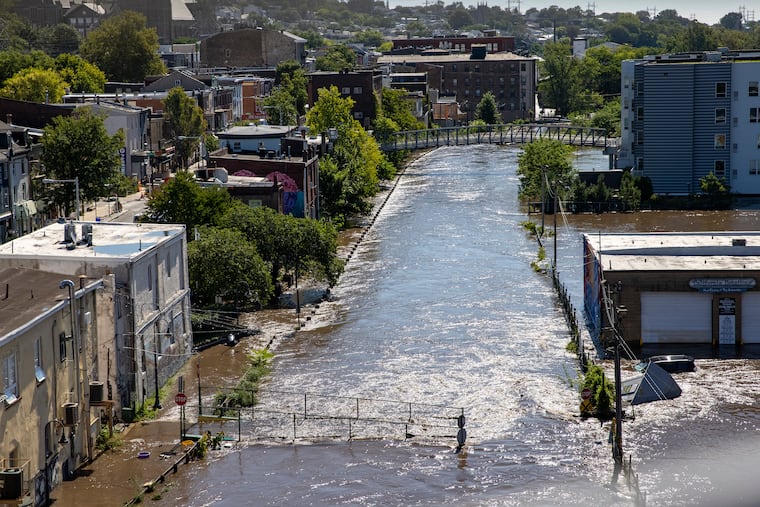Cleaner air may help explain why we’re seeing so many Atlantic hurricanes
Conversely, pollution may be dampening hurricane activity in the western Pacific.

The Atlantic Basin has been a cauldron of tropical-storm activity in recent years, and the evidence indicts an unlikely conspirator for playing a role in the uptick in the last two decades — cleaner air.
That’s the conclusion of a paper, published Wednesday in the journal Science Advances, that argues that lower pollution levels over the United States and Europe have helped set off a sequence of changes that have warmed the North Atlantic and turned it into a tropical hotbed.
After two dizzying seasons that have had significant impacts in the Philadelphia region, forecasters are seeing yet another active one in 2022.
» READ MORE: Another busy Atlantic hurricane season is likely, forecasters say
Conversely, increases in industrial polluting aerosols over India and China have cooled the storm traffic in the western Pacific, where numbers are down “substantially.”
Nothing in the atmosphere happens simply, cautioned the study’s author, NOAA scientist Hiro Murakami. “Natural variability also is important,” he said in a phone interview, as are veils of volcanic ash and, of course, the increasing carbon dioxide levels that have been raising the planet’s temperatures and impacting the climate system.
But Murakami and other researchers, such as Adam H. Sobel and Suzana J. Camargo at Columbia University’s Lamont-Doherty Observatory, who co-authored related papers in 2016 and 2019, hold that the case for pollution’s impacts on tropical storms is powerful.
“Murakami’s conclusions are broadly consistent with ours,” said Sobel, however the new paper “adds useful regional specificity and shows how the North Atlantic is different than the Pacific due to their different aerosol histories.”
Murakami said that polluting aerosols, primarily sulfates, formed by burning coal and oil, could be acting as unnatural counterparts to the Saharan Air Layer, the upper-air plumes of desert dust that can inhibit tropical storm development in the Atlantic Basin, which includes the Caribbean Sea and the Gulf of Mexico.
Something in the air
Murakami, project scientist with the Geophysical Fluid Dynamics Laboratory in Princeton, noted that previous research had addressed the links between pollution and tropical storms, one notable example being aerosols’ role in filtering ocean-warming sunlight. That would compromise the heat-energy supplies that are hurricanes’ lifeblood.
However cleaner air not only would peel away those filters, through a complicated set of interactions, it would cultivate tropical storms in the North Atlantic while making the storm climate barren in the Southern Hemisphere, Murakami wrote.
Temperature contrasts drive winds, and the overall warming related to pollution controls would weaken the west-to-east upper-air winds that could shear off storms before they grow into tropical storms, which are stoked by rising currents. Rising air carries moisture into the cooler high atmosphere where it can condense, setting off convective thunderstorms.
» READ MORE: More tropical storms are making U.S. landfall, and Philly is feeling the fallout
Conversely, the sinking air that surrounds cyclones has a drying effect, and Murakami holds that the storminess in the North Atlantic has quieted the tropics in the Southern Hemisphere.
His study covered a 40-year period during which the United States and Europe have instituted pollution-control measures.
He found that the total of days in which storms were active jumped 30.6% in the 2001-20 period, compared with the prior 20-year period. By contrast, the total dropped 22.3% in the western Pacific.
Climate change
Teasing out all variables blowing in the chaotic winds is a cosmically complicated pursuit. For example, researchers have documented that historically “lull” and “active” Atlantic hurricane seasons have alternated in 25- to 40-year cycles, and an active period began in 1995. That likely has had something to do with the bump in the Atlantic. Plus storm-detection technology keeps improving with satellite and radar advances.
In the meantime, no one is suggesting that pollution, an ongoing worldwide health crisis, is the solution to the hurricane problem, and Sobel and his colleagues hold that any dampening effects would be temporary.
» READ MORE: New Jersey could be among the states hardest hit by future flooding
They wrote that while aerosols have mitigated increases in hurricane intensity that would be expected in a warmer climate, “future greenhouse gas forcing of potential intensity will increasingly dominate over aerosol forcing.”
The outlook
Regardless of whether cleaner air would be a factor, the consensus forecast is that the 2022 Atlantic season is going to be an active one. All the major preseason outlooks call for above-average numbers of hurricanes, those with winds of 74 mph or more, and tropical storms, with winds of at least 39 mph.
Ominously, the Climate Prediction Center has increased the odds that a La Niña cooling of the tropical Pacific will persist into the hurricane season, which begins officially on June 1. When the tropical Pacific cools, those west-to-east shearing winds over the Atlantic tend to slacken.
It is likely that projected numbers will increase with forecast updates.
AccuWeather Inc. has called for 16 to 20 named storms — 14 is the average — but long-range specialist Paul Pastelok said he wouldn’t be surprised if the numbers run into the low 20s.
Said Pastelok, “It could be a nasty hurricane season.”